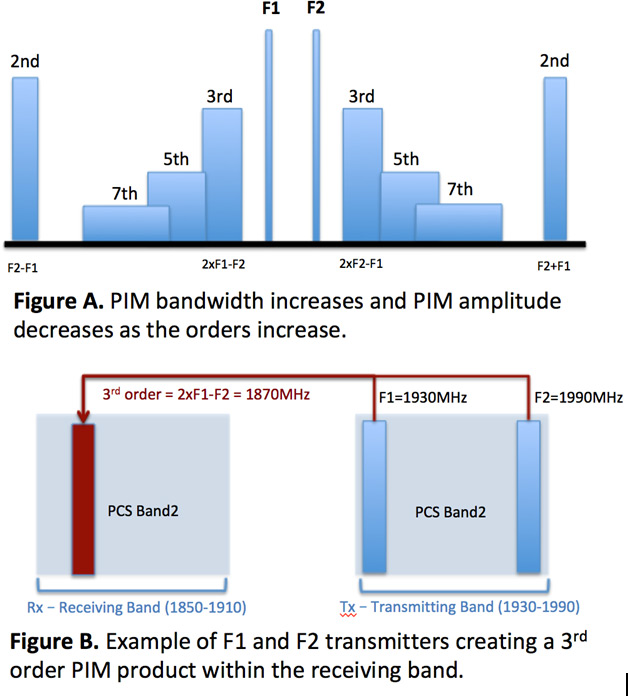
Passive Intermodulation (PIM)
An Introduction
As wireless research and testing extend beyond the lab and onto the field, Passive intermodulation (PIM) issues are a growing challenge for network designers and cell operators.
The ability to identify, troubleshoot and resolve passive intermodulation will require wireless service providers to utilize portable PIM analyzers and RF components with acceptable low PIM performance. Operating knowledge of the PIM sources will also play a part in resolving PIM-related issues, including proper installation and maintenance of the antenna and RF cabling system.
What is Passive Intermodulation (PIM)?
Passive Intermodulation (PIM) occurs when two or more signals are present in passive (mechanical) components of a wireless system.Some examples of mechanical components include antennas, cables and connectors.
The signals can mix or multiply with each other to generate other signals that impact the original intended signal; this results in degraded cellular receiver performance, and from a user perspective, this can severely impact voice calls and data transmission quality for the end user client.
PIM frequencies can be expressed by frequencies F1 and F2 as follows:
aF1 – bF2 [1]
aF2 – bF1 [2]
,where the constants a and b are positive integers.
When added, the result is called the PIM product order. As an example, if a=1 and b=2, the result is a third-order product. See Figure 2 for an example of this impacting the PCS frequency band 2.

Sources of PIM
Major sources of PIM can be found from both internal and external factors. Some examples of internal factors include loose connectors, damaged cables, and improperly installed RF components. External factors include corrosion and rust on ferromagnetic materials (iron, nickel and cobalt), and dirt and contamination that forms from aging conductor surfaces. Geographical regions with extreme outdoor temperature and humidity climates can also be an external contributor that impact component material integrity.
Outdoor cellular systems with higher RF power can generate a significant amount of intermodulation distortion. PIM impact is directly related to power by a 1:3 ratio; every +1dB increase (or decrease) of power corresponds to an additional +3dB PIM increase (or decrease). Unlike GSM frequencies with very narrow bands, 5G systems have wider frequency ranges; this potentially introduces more cross band PIM complications, which can only be avoided by using passive components with low PIM rejection specifications.
Introducing ‘Extra’ Low PIM design:
To meet the design challenges of PIM across multiple different RF systems, passive components engineered below the absolute lowest noise floor could meet the variability of multiple use cases:
- For UMTS systems the receiver sensitivity is -119dBm, which requires at least -162dBc PIM
- For LTE systems the receiver sensitivity is -126dBm, which requires at least -169dBc PIM
- For higher power wireless systems greater than 46dBm such as outdoor DAS and cellular systems, <-165dBc PIM is required to avoid PIM impacts.
-
One such example is Radiocomm's latest set of Low PIM Hybrid Couplers launched in mid 2019 that achieves -165dBc PIM across a wideband frequency of 520MHz-6000Mhz:

Figure C: Low PIM Hybrid Coupler that achieves -165dc PIM across a wideband frequency of 520MHz-6000MHz
Conclusion
As wireless service providers design and operate new and existing systems, extra care and education will be required to ensure the system design is accounting for issues related to PIM. Choosing passive components engineered for these conditions is a critical step in the journey for stable and expected network performance.
References:
-
https://www.analog.com/en/analog-dialogue/articles/passive-intermodulation-effects-in-base-stations-understanding-the-challenges-and-solutions.html
-
https://www.anritsu.com/en-US/test-measurement/technologies/pim
-
https://www.electronicdesign.com/wireless/passive-intermodulation-pim-what-you-need-know
Have a question or comment?
We'd love to hear it. Fill out our General Inquiry Form or reach us directly at: info@acentury.co
CONTACT US